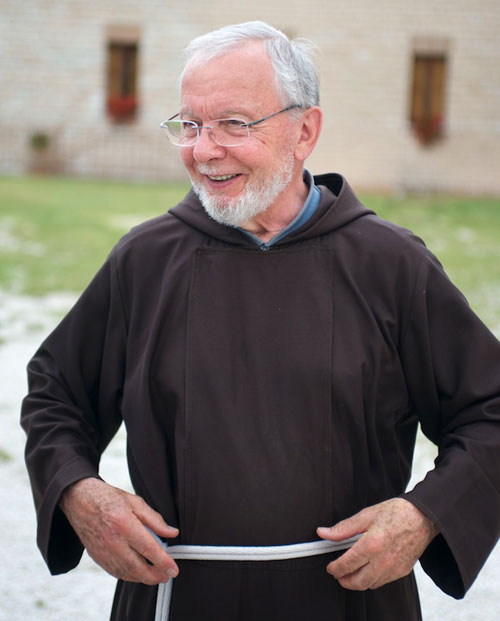
He devotes his mornings to prayer, but his evenings belong to Satan
FOSSOMBRONE, Italy — Father Aurelio Gino Pela is a man of God, a Roman Catholic priest who tends a flock of the still devout in the central Italian province of Le Marche.
But a few times each month he sits down with Satan.
“The other day it happened that a person knocked me on the ground, and I was lucky that her husband and another lady held her because she would have jumped on me,” said Pela, 73, recalling a recent exorcism he conducted.
Pela isn’t a character from a Hollywood film, or a rogue priest straying into the bizarre. He’s a Vatican-appointed exorcist, one of hundreds in Italy. Commissioned by the Church in spiritual warfare, Pela and his colleagues extract demons from those plagued by unexplainable behavior.
Exorcism isn’t a hidden rite here, but an accepted part of spiritual life. The Vatican oversees an exorcism bureaucracy — a structured, organized system with official exorcists appointed by local bishops. And in a country where a study published by the Italian Catholic magazine Famiglia Cristiana and Jesus revealed that 34% of the residents believe in demonology, it’s not surprising exorcists like Aurelio stay busy.
Father Pela claims to perform an average of 15 exorcisms week, which would come to more than 2,000 during his three-year career.
It wasn’t a job he applied for; he was recruited by an old friend, the bishop of the nearby city of Fano, on the Adriatic Sea.
“I was appointed exorcist by the bishop of Fano because as a rule the exorcist of a diocese is the bishop, and then it’s the bishop that appoints someone to substitute him or aid him with this duty,” Pela explaine. “Initially I didn’t want to be an exorcist, because it’s a heavy sort of duty, it involves risks, even personal ones.”
But Pela accepted the responsibility, and today he goes about this most unusual calling with an almost business-like daily routine.
Driving a purple car, he arrives every morning at the gates of the Beato Benvenuto monastery, a castle-like brick structure resting on a daunting hilltop overlooking Fossombrone. His mornings are set aside for prayer, but his evenings are reserved for Satan.
Like a sought-after therapist, Pela limits his exorcism appointments to hourly sessions, and always has a clinical psychologist at his side. His clients, he said, fall into three general categories — the mentally ill, those who fear they have been cursed by members of the occult and those truly possessed by demons.
To the first two groups, he and the psychologist offer prayers and advice.
“After listening to the person I decide if a prayer of liberation or an exorcism is to be done,” he said. “It depends on the necessities of the person.”
Some are simply mentally ill, he said. “They need to be cured by a psychiatrist, because many of them have problems of this sort. So I tell them that a prayer of liberation is important, but maybe it’s at least as important for them to be followed by a psychiatrist.”
Major exorcisms are for cases of true demonic possessions. “Diabolic possessions — these cases are really rare,” said Pela.
Pela claims to observe approximately two major exorcisms each month. The afflicted often react violently to holy objects, prayers or just his presence — all symptomatic of demonic intrusion.
Pela, citing privacy issues, refused to allow media at one of his exorcisms. However, the church has published The Rite of Exorcism, which details exorcism rituals.
He encourages the patient’s family or friends to attend — not only for his subject’s sake, but for his own.
“In some cases it has been necessary to hold a person still with more than a man, in some cases even three,” he said.
He recently observed a patient collapse, and to slither about the room like a snake.
“He’s a good Catholic, a practitioner too, but he’s disturbed,” Pela said. “When I perform the exorcism on him, he shakes on the floor like a snake, and it’s impossible to hold him still. After the exorcism he’s exhausted; he lacks the strength even to get up.”
Pela has never seen a patient’s head do a 360, as in the iconic scene from the movie The Exorcist; nor has he seen anyone break spontaneously into a foreign tongue.
One of the discrepancies between Hollywood and Italian exorcism rituals lies in the use of water. Pela said he uses salt water rather than holy water during an exorcism. This way, his clients can bring the salt water home, and reuse it. Holy water can only be used for blessings within the church.
“Exorcised salt is used to make the Enemy flee from an environment, and the water does the same. I exorcise salt and water so that the people can use it around their homes in order to free them from this negative influence,” he explained.
Minor exorcisms comprise most of Pela’s work. These are less complex. In those cases, he’ll recite a series of brief prayers, known as prayers of liberation, to bring sufferers release.
Some of those he treats are under the influence of “tarot readers, magi, witches and black masses,” he maintained, a symptom of the active interest in the occult in many parts of Italy.
“Witches use things like puppets with needles, chicken heads with needles,” he said. “They use particular cushions for curses and many other things. Those cases are pretty frequent. So they need to be freed.”
In an occupation defined by the unusual, Pela is always prepared for surprises, such as the time a client was referred to him by a witch.
“He said the reason was that ‘the witch I used to go to told me she cannot do anything more for my problem, and she gave me your number,’ Pela recalled. “This is strange - really strange — but sometimes [witches, wizards and warlocks] might feel powerless, and this is what happens.”
“In fact, I do ask them: ‘Why is a tarot reader sending you to me?”‘
“Magic practitioners work for the enemy, so for someone who works for the enemy to send his customers to an exorcist is certainly weird.”
Dorian Geiger studies at the University of British Columbia. This story was adapted from Urbino Project 2011, the web magazine of an annual multimedia journalism program sponsored by The Institute for Education in International Media, Iowa State University and James Madison University.
What's your view?
You must be logged in to post a comment.




